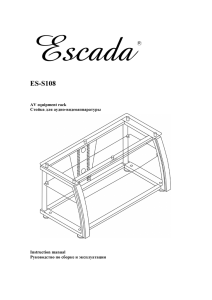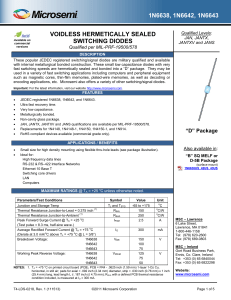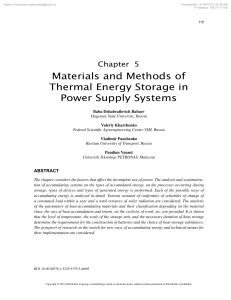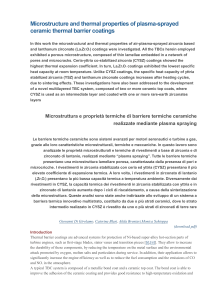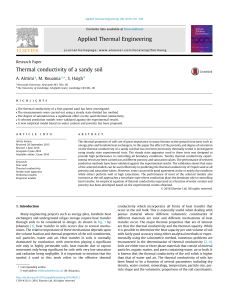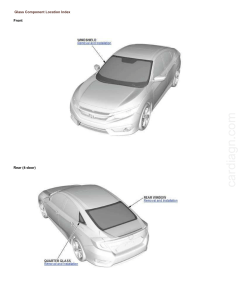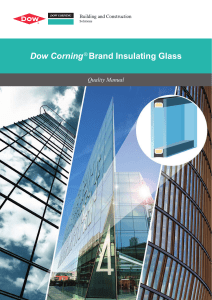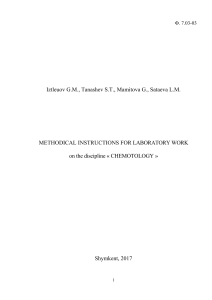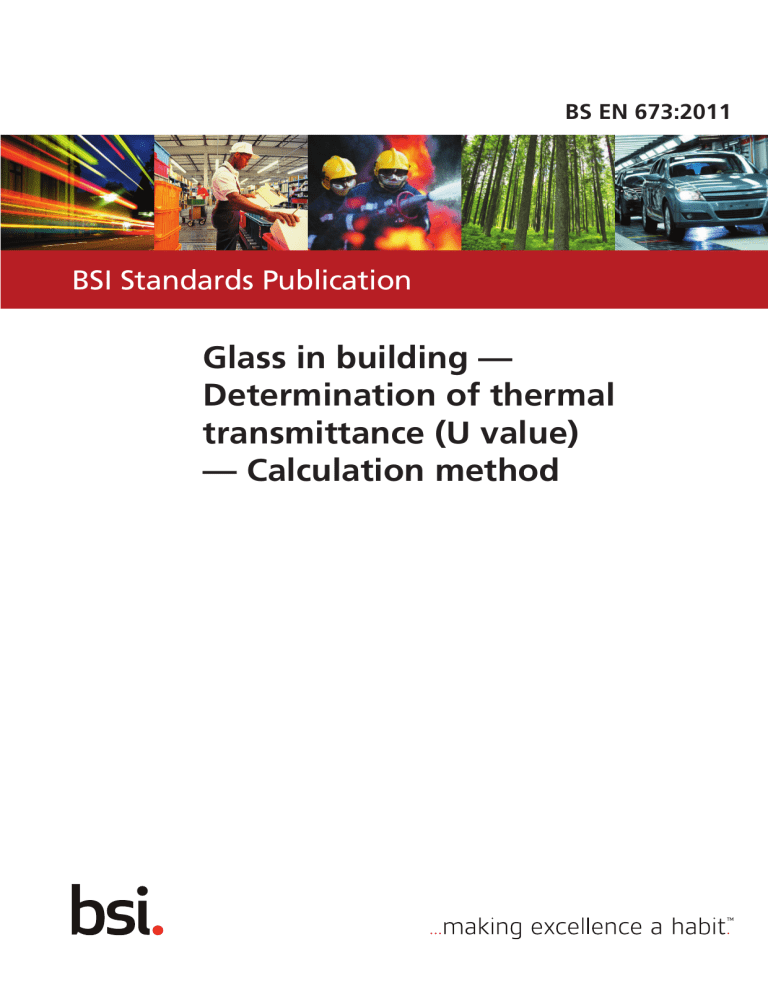
BS EN 673:2011 BSI Standards Publication Glass in building — Determination of thermal transmittance (U value) — Calculation method BS EN 673:2011 BRITISH STANDARD National foreword This British Standard is the UK implementation of EN 673:2011. It supersedes BS EN 673:1998, which is withdrawn. The UK participation in its preparation was entrusted to Technical Committee B/520/4, Properties and glazing methods. A list of organizations represented on this committee can be obtained on request to its secretary. This publication does not purport to include all the necessary provisions of a contract. Users are responsible for its correct application. © BSI 2011 ISBN 978 0 580 71226 5 ICS 81.040.20 Compliance with a British Standard cannot confer immunity from legal obligations. This British Standard was published under the authority of the Standards Policy and Strategy Committee on 31 May 2011. Amendments issued since publication Date Text affected BS EN 673:2011 EN 673 EUROPEAN STANDARD NORME EUROPÉENNE EUROPÄISCHE NORM February 2011 ICS 81.040.20 Supersedes EN 673:1997 English Version Glass in building - Determination of thermal transmittance (U value) - Calculation method Verre dans la construction - Détermination du coefficient de transmission thermique, U - Méthode de calcul Glas im Bauwesen - Bestimmung des U-Werts (Wärmedurchgangskoeffizient) - Berechnungsverfahren This European Standard was approved by CEN on 2 January 2011. CEN members are bound to comply with the CEN/CENELEC Internal Regulations which stipulate the conditions for giving this European Standard the status of a national standard without any alteration. Up-to-date lists and bibliographical references concerning such national standards may be obtained on application to the CEN-CENELEC Management Centre or to any CEN member. This European Standard exists in three official versions (English, French, German). A version in any other language made by translation under the responsibility of a CEN member into its own language and notified to the CEN-CENELEC Management Centre has the same status as the official versions. CEN members are the national standards bodies of Austria, Belgium, Bulgaria, Croatia, Cyprus, Czech Republic, Denmark, Estonia, Finland, France, Germany, Greece, Hungary, Iceland, Ireland, Italy, Latvia, Lithuania, Luxembourg, Malta, Netherlands, Norway, Poland, Portugal, Romania, Slovakia, Slovenia, Spain, Sweden, Switzerland and United Kingdom. EUROPEAN COMMITTEE FOR STANDARDIZATION COMITÉ EUROPÉEN DE NORMALISATION EUROPÄISCHES KOMITEE FÜR NORMUNG Management Centre: Avenue Marnix 17, B-1000 Brussels © 2011 CEN All rights of exploitation in any form and by any means reserved worldwide for CEN national Members. Ref. No. EN 673:2011: E BS EN 673:2011 EN 673:2011 (E) Contents Page Foreword ..............................................................................................................................................................3 Introduction .........................................................................................................................................................4 1 Scope ......................................................................................................................................................4 2 Normative references ............................................................................................................................5 3 Terms and definitions ...........................................................................................................................5 4 4.1 4.2 4.3 Symbols, dimensionless numbers and subscripts ............................................................................5 Symbols ..................................................................................................................................................5 Dimensionless Numbers .......................................................................................................................6 Subscripts ..............................................................................................................................................6 5 5.1 5.2 5.3 5.4 5.4.1 5.4.2 5.4.3 Basic formulae .......................................................................................................................................7 General ....................................................................................................................................................7 U value ....................................................................................................................................................7 Radiation conductance hr .....................................................................................................................8 Gas conductance hg ..............................................................................................................................8 General ....................................................................................................................................................8 Vertical glazing.......................................................................................................................................9 Horizontal and angled glazing ..............................................................................................................9 6 6.1 6.2 6.3 Basic material properties ......................................................................................................................9 Emissivity ...............................................................................................................................................9 Gas properties..................................................................................................................................... 10 Infrared absorption of the gas ........................................................................................................... 12 7 7.1 7.2 7.3 External and internal heat transfer coefficients .............................................................................. 12 External heat transfer coefficient he ................................................................................................. 12 Internal heat transfer coefficient hi ................................................................................................... 12 Design values ...................................................................................................................................... 13 8 Declared values: standardized boundary conditions ..................................................................... 13 9 9.1 9.2 Expression of the results ................................................................................................................... 14 U values ............................................................................................................................................... 14 Intermediate values ............................................................................................................................ 14 10 10.1 10.2 10.3 10.4 Test report ........................................................................................................................................... 14 Information included in the test report ............................................................................................. 14 Identification of the glazing ............................................................................................................... 14 Cross section of the glazing .............................................................................................................. 15 Results ................................................................................................................................................. 15 Annex A (normative) Iteration procedure for glazing with more than one gas space .............................. 16 Bibliography ..................................................................................................................................................... 18 2 BS EN 673:2011 EN 673:2011 (E) Foreword This document (EN 673:2011) has been prepared by Technical Committee CEN/TC 129 “Glass in building”, the secretariat of which is held by NBN. This European Standard shall be given the status of a national standard, either by publication of an identical text or by endorsement, at the latest by August 2011, and conflicting national standards shall be withdrawn at the latest by August 2011. Attention is drawn to the possibility that some of the elements of this document may be the subject of patent rights. CEN [and/or CENELEC] shall not be held responsible for identifying any or all such patent rights. This document supersedes EN 673:1997. This document has been prepared under a mandate given to CEN by the European Commission and the European Free Trade Association, and supports essential requirements of EU Directive(s). According to the CEN/CENELEC Internal Regulations, the national standards organizations of the following countries are bound to implement this European Standard: Austria, Belgium, Bulgaria, Croatia, Cyprus, Czech Republic, Denmark, Estonia, Finland, France, Germany, Greece, Hungary, Iceland, Ireland, Italy, Latvia, Lithuania, Luxembourg, Malta, Netherlands, Norway, Poland, Portugal, Romania, Slovakia, Slovenia, Spain, Sweden, Switzerland and United Kingdom. 3 BS EN 673:2011 EN 673:2011 (E) Introduction CEN/TC 129/WG9 "Light and energy transmission, thermal insulation" prepared a working draft based on the document ISO/DIS 10292, "Thermal insulation of glazing: Calculation rules for determining the steady state U value of double or multiple glazing", document that was prepared by ISO/TC 160, "Glass in building". This was published in 1997 as EN 673. This edition is a revision of EN 673:1997. The main change in this edition is that the internal and external heat transfer coefficients have been amended slightly to avoid any ambiguities. The original annex on the determination of emissivity has been removed and reference is made to EN 12898. Other changes include the incorporation of amendments A1 and A2 to EN 673:1997 and general improvements to the text to aid understanding. 1 Scope This European Standard specifies a calculation method to determine the thermal transmittance of glazing with flat and parallel surfaces. This European Standard applies to uncoated glass (including glass with structured surfaces, e.g. patterned glass), coated glass and materials not transparent in the far infrared which is the case for soda lime glass products, borosilicate glass and glass ceramic. It applies also to multiple glazing comprising such glasses and/or materials. It does not apply to multiple glazing which include in the gas space sheets or foils that are far infrared transparent. The procedure specified in this European Standard determines the U value1) (thermal transmittance) in the central area of glazing. The edge effects due to the thermal bridge through the spacer of a sealed glazing unit or through the window frame are not included. Furthermore, energy transfer due to solar radiation is not taken into account. The effects of Georgian and other bars are excluded from the scope of this European Standard. The standard for the calculation of the overall U value of windows, doors and shutters (see EN ISO 10077-1 [1]) gives normative reference to the U value calculated for the glazing components according to this standard. For the purpose of product comparison, a vertical position of the glazing is specified. In addition, U values are calculated using the same procedure for other purposes, in particular for predicting: heat loss through glazing; conduction heat gains in summer; condensation on glazing surfaces; the effect of the absorbed solar radiation in determining the solar factor (see Bibliography, [2]). Reference should be made to [3], [4] and [5] or other European Standards dealing with heat loss calculations for the application of glazing U values determined by this standard. A procedure for the determination of emissivity is given in EN 12898. 1) 4 In some countries the symbol k has been used hitherto. BS EN 673:2011 EN 673:2011 (E) The rules have been made as simple as possible consistent with accuracy. 2 Normative references The following referenced documents are indispensable for the application of this document. For dated references, only the edition cited applies. For undated references, the latest edition of the referenced document (including any amendments) applies. EN 674, Glass in building — Determination of thermal transmittance (U value) — Guarded hot plate method EN 675, Glass in building — Determination of thermal transmittance (U value) — Heat flow meter method EN 12898, Glass in building — Determination of the emissivity 3 Terms and definitions For the purposes of this document, the following terms and definitions apply. 3.1 U value parameter of glazing which characterizes the heat transfer through the central part of the glazing, i.e. without edge effects, and states the steady-state density of heat transfer rate per temperature difference between the environmental temperatures on each side The U value is given in watts per square metre Kelvin [W/(m2⋅K)]. NOTE 3.2 declared value U value obtained under standardized boundary conditions (see Clause 8) 4 Symbols, dimensionless numbers and subscripts 4.1 Symbols A constant - c specific heat capacity of gas J/(kg⋅K) d thickness of material layer (glass or alternative glazing material) m F volume fraction - h - heat transfer coefficient W/(m2⋅K) - also thermal conductance W/(m2⋅K) M number of material layers - n exponent - N number of spaces - 5 BS EN 673:2011 EN 673:2011 (E) r thermal resistivity of glass (glazing material) m⋅K/W P gas property - s width of gas space m T absolute temperature K U thermal transmittance W/(m2⋅K) ∆Τ temperature difference K ε corrected emissivity - εn normal emissivity (perpendicular to the surface) - ρ gas density kg/m3 σ Stefan-Boltzmann's constant 5,67 x 10-8 W/(m2⋅K4) µ dynamic viscosity of gas kg/(m⋅s) λ - thermal conductivity of gas in space W/(m⋅K) ϑ temperature on the Celsius scale °C 4.2 Dimensionless Numbers Gr Grashof number - Nu Nusselt number - Pr Prandtl number - 4.3 6 Subscripts c convection e external i internal j j material layer k k space g gas m mean n normal r radiation s space th th BS EN 673:2011 EN 673:2011 (E) 5 5.1 t total 1;2 first, second etc. Basic formulae General The method of this standard is based on a calculation according to the following principles. 5.2 U value The U value is given by: 1 1 1 1 = + + U he ht hi (1) where he and hi are the external and internal heat transfer coefficients; ht is the total thermal conductance of the glazing. N M 1 1 = ∑ + ∑ d j ⋅ rj ht 1 hs 1 (2) where hs is the thermal conductance of each gas space; N is the number of spaces; dj is the thickness of each material layer; rj is the thermal resistivity of each material (thermal resistivity of soda lime glass = 1,0 m⋅K/W); M is the number of material layers. hs,k = hr,k + hg,k (3) where th hs,k is the heat transfer of the k space; hr,k is the radiation conductance; hg,k is the U value of gas. NOTE The thermal resistivity of components other than glass (e.g. interlayers in laminated glass) may be taken into account in determining the U value. For the purpose of this standard, thermal conductivity values used for glass in building should be obtained from the table of generally accepted values in the relevant product standard (e.g. EN 572-1 for basic soda lime silicate glass). In instances where the effects are not considered significant or important, a simplified approach may be taken, i.e. ignoring the effects of components other than glass. 7 BS EN 673:2011 EN 673:2011 (E) 5.3 Radiation conductance hr The radiation conductance is given by: −1 1 1 hr = 4σ + − 1 Tm,3 k ε 1,k ε 2,k (4) where σ is the Stefan-Boltzmann's constant; Tm,k is the mean absolute temperature of the gas space; ε1,k and ε2,k are the corrected emissivities of the surfaces bounding the enclosed space between the panes at Tm,k. Gas conductance hg 5.4 5.4.1 General The gas conductance is given by: hg ,k = Nu λk (5) sk where th sk is the width of the k space; λk is the thermal conductivity of the kth gas; Nu is the Nusselt number. Nu = A ⋅ (Gr ⋅ Pr)n (6) where A is a constant; Gr is the Grashof number; Pr is the Prandtl number; n is an exponent. Gr = Pr = 8 µc λ 9 , 81 s 3 ∆ T ⋅ ρ Tm µ 2 2 (7) (8) BS EN 673:2011 EN 673:2011 (E) where ∆ T is the temperature difference between glass surfaces bounding the gas space; ρ is the density; µ is the dynamic viscosity; c is the specific heat capacity; Tm is the mean temperature. The Nusselt number is calculated from Equation (6). If Nu is less than 1, then the value unity is used for Nu in Equation (5). 5.4.2 Vertical glazing For vertical glazing: A is 0,035 n is 0,38 5.4.3 Horizontal and angled glazing For horizontal or angled glazing and upward heat flow the heat transfer by convection is enhanced. This effect shall be considered by substituting the following values of A and n in Equation (6). Horizontal spaces A = 0,16 n = 0,28 Space at 45° A = 0,10 n = 0,31 For intermediate angles linear interpolation is satisfactory; however, the linear interpolation shall be between the two nearest points. When the direction of heat flow is downward the convection shall be considered suppressed for practical cases and Nu = 1 is substituted in Equation (5). 6 6.1 Basic material properties Emissivity The corrected emissivities ε of the surfaces bounding the enclosed spaces are required to calculate the radiation conductance hr in Equation (4). For uncoated soda lime glass surfaces or for soda lime glass surfaces with coatings which have no effect on the emissivity, the corrected emissivity to be used is 0,837. NOTE 1 With reasonable confidence the same value may be used for uncoated borosilicate glass. For other coated surfaces the normal emissivity ε n shall be determined with an infrared spectrometer in accordance with EN 12898. The corrected emissivity shall be determined from the normal emissivity in accordance with EN 12898. 9 BS EN 673:2011 EN 673:2011 (E) NOTE 2 Two different definitions of emissivity should be theoretically used to describe radiation exchange between: a) glass surfaces facing each other in glazing; b) a glass surface facing a room. However, in practice numerical differences are found to be negligibly small. Thus corrected emissivity describes both types of heat exchange with a sufficient approximation. NOTE 3 For laminated glass and laminated safety glass where a low emissivity coating is in direct contact with an interlayer, the effect of the low emissivity coating is negated, in terms of U value. 6.2 Gas properties The properties of the gas filling the space are required. These are: thermal conductivity λ density ρ dynamic viscosity µ specific heat capacity c The relevant values are substituted in Equations (7) and (8) above for the Grashof and Prandtl numbers and the Nusselt number is determined from Equation (6) above. If the Nusselt number is greater than 1 this indicates that convection is occurring, enhancing the heat flow rate. If the calculated value of the Nusselt number is less than 1 this indicates that heat flow in the gas is by conduction only and the Nusselt number is given the bounding value of 1. Substitution in Equation (5) gives the gas conductance hg. Values of gas properties for a range of gases used in sealed glazing units are given in Table 1. For all practical gas mixtures the gas properties are proportioned in the ratio of the volume fractions, F1, F2..., with sufficient approximation: Gas 1: F1; Gas 2: F2 etc. Thus P = P1 F1 + P2 F2 where P represents the relevant property: thermal conductivity, density, viscosity or specific heat capacity. 10 (9) BS EN 673:2011 EN 673:2011 (E) Table 1 — Gas properties gas Air temperature density ϑ ρ °C kg/m3 λ c J/(kg⋅K) µ kg/(m⋅s) W/(m⋅K) 1,661 x 10-5 2,336 x 10-2 0 1,277 1,711 x 10-5 2,416 x 10-2 1,232 1,761 x 10-5 2,496 x 10-2 20 1,189 1,811 x 10-5 2,576 x 10-2 -10 1,829 2,038 x 10-5 1,584 x 10-2 0 1,762 2,101 x 10-5 1,634 x 10-2 1,699 2,164 x 10-5 1,684 x 10-2 20 1,640 2,228 x 10-5 1,734 x 10-2 -10 3,832 2,260 x 10-5 0,842 x 10-2 0 3,690 2,330 x 10-5 0,870 x 10-2 3,560 2,400 x 10-5 0,900 x 10-2 20 3,430 2,470 x 10-5 0,926 x 10-2 -10 6,121 2,078 x 10 0 5,897 2,152 x 10 5,689 2,226 x 10 5,495 10 Xenon specific heat capacity 1,326 10 Krypton conductivity - 10 10 Argon dynamic viscosity 10 a a a a 20 SF6 (see -10 Note b) 0 10 a 20 -5 0,494 x 10 -5 0,512 x 10 -5 0,529 x 10 2,299 x 10 -5 0,546 x 10 6,844 1,383 x 10-5 1,119 x 10-2 6,602 1,421 x 10-5 1,197 x 10-2 6,360 1,459 x 10-5 1,275 x 10-2 6,118 1,497 x 10-5 1,354 x 10-2 1,008 x 103 0,519 x 103 0,245 x 103 -2 -2 -2 0,161 x 103 -2 0,614 x 103 a Standardized boundary conditions b Sulphur hexafluoride NOTE The use of SF6 gas has been banned in some parts of the world, including the European Union. For this reason, the gas properties of SF6 have been given primarily for the purposes of historical comparison. 11 BS EN 673:2011 EN 673:2011 (E) 6.3 Infrared absorption of the gas Some gases absorb infrared radiation in the 5 µm to 50 µm range. Where the gas concerned is used in combination with a coating with corrected emissivity less than 0,2 this effect is neglected because of the low density of the net infrared radiant flux. For other cases the U value shall be measured according to EN 674 or EN 675, if the possible improvement is to be taken into account. 7 External and internal heat transfer coefficients 7.1 External heat transfer coefficient he The external heat transfer coefficient he is a function of the wind speed near the glazing, the emissivity and other climatic factors. For ordinary vertical glass surfaces the value of he is standardised to 25 W/(m 2⋅K) for the purposes of comparison of glazing U values. NOTE The reciprocal 1 he 2 is 0,04 m ·K / W This procedure does not consider the improvement of the U value due to the presence of externally exposed coated surfaces with an emissivity lower than 0,837. For the he values of non-vertical surfaces reference is made to [3]. 7.2 Internal heat transfer coefficient hi The internal heat transfer coefficient hi is given by the following formula: hi = hr + hc (10) where hr is the internal radiative heat transfer coefficient; hc is the internal convective heat transfer coefficient. For the purposes of this standard, the radiation conductance for uncoated soda lime glass surfaces is 4,1 W/(m2⋅K). If the internal surface of the glazing has a lower emissivity the radiation conductance is given by: hr = 4, 1 ε 0, 837 where ε is the corrected emissivity of the coated surface; 0,837 is the corrected emissivity of uncoated soda lime glass (see 6.1). 12 (11) BS EN 673:2011 EN 673:2011 (E) This is only applicable if there is no condensation on the coated surface. A procedure for determining the corrected emissivity of a coating is given in EN 12898. The value of hc is 3,6 W/(m2⋅K) for free convection. Where a fan blown heater is situated below or above a window this value will be larger if a current of air is blown over the window. For vertical soda lime glass surfaces and free convection W/(m2⋅K) hi = 4,1 + 3,6 = 7,7 (12) which is standardised for the purposes of comparison of glazing U values. NOTE The reciprocal 1 hi for soda lime glass surfaces is 0,13 m2⋅K/W.expressed to two decimal figures. For the hi values of non-vertical surfaces reference is made to [3]. 7.3 Design values For the application of glazing U values in building design the use of a declared value may not always be sufficiently accurate. In special circumstances, a design value shall be determined using this standard. Design U values appropriate to the position of the glazing and the environmental conditions shall be determined using the correct boundary values of hs, he and hi which shall be stated. NOTE The application of the declared value of an external building element for calculating heat losses is not strictly consistent on the basis of dry resultant temperature in internally heated spaces. In most practical cases, it is adequate, but for glazing elements with relatively large surface area and particularly with internal low emissivity surface, errors may arise. For heat loss calculations reference is made to [3], [4], [5] or other relevant European Standards. 8 Declared values: standardized boundary conditions For all cases where U values are stated for promotional purposes the standardized boundary conditions defined below shall be used. The standardized boundary conditions for declared values are: r thermal resistivity of soda lime glass ε corrected emissivity of uncoated soda lime and 1,0 m·K/W borosilicate glass surface 0,837 ∆ T temperature difference between bounding glass surfaces 15 K Tm mean temperature of gas space 283 K σ Stefan-Boltzmann's constant 5,67 x 10-8 W/(m2⋅K4) he external heat transfer coefficient for uncoated soda lime glass surfaces hi 25 W/(m 2⋅K) internal heat transfer coefficient 13 BS EN 673:2011 EN 673:2011 (E) for uncoated soda lime glass surfaces 7,7 W/(m2⋅K) A constant 0,035 n exponent 0,38 Standardized boundary conditions for the gas properties are given in Table 1 for a temperature of 10 °C (283K). 9 9.1 Expression of the results U values In all cases, U values shall be expressed in W/(m 2⋅K) rounded to one decimal figure. If the second decimal is five, it shall be rounded to the higher values. Example 1: 1,53 becomes 1,5; Example 2: 1,55 becomes 1,6; Example 3: 1,549 becomes 1,5. 9.2 Intermediate values In computations, intermediate values shall not be rounded. 10 Test report 10.1 Information included in the test report The test report shall state the following elements. 10.2 Identification of the glazing total thickness of the glazing (millimetres); thickness of each glass pane (millimetres); thickness of each material layer, if any (millimetres); thickness of gas space(s) (millimetres); type of gas filling; position of IR-reflecting coating, if any; inclination of glazing (angle to horizontal); any other condition diverging from the standardized boundary conditions. 14 BS EN 673:2011 EN 673:2011 (E) 10.3 Cross section of the glazing A figure shall show the structure of the glazing (position and thickness of glass panes and of material layers, position of coating(s), position and thickness of gas space(s), type of gas filling). The layers of glass and of other materials and the gas spaces shall be numbered starting from the pane facing outside. 10.4 Results corrected emissivity of the coating, in the case of coatings which modify the emissivity internal heat transfer coefficient hi, in the case of coatings which modify the emissivity [W/(m2⋅K)] total thermal conductance of the glazing, ht [W/(m2⋅K)] U value of the glazing [W/(m2⋅K)] hs, he and hi if used to calculate a design U value in which case the expression "design U value" shall be used [W/(m2⋅K)] 15 BS EN 673:2011 EN 673:2011 (E) Annex A (normative) Iteration procedure for glazing with more than one gas space For glazing with more than one gas space (N>1), the calculation shall be performed by an iteration procedure (exemplified in Table A.1), in which the gas space conductance hs of each gas space is determined at a mean temperature of 283 K (sufficient accuracy is obtained because the influence of small deviations from 283 K can be neglected). For the first step of the iteration procedure a temperature difference of ∆ T = 15/N (K) for each space is used in Equation (7). With gas space conductances hs obtained, new equation: ∆ T s = 15 ∆ Ts -values for each space shall be calculated from the 1/hs (A.1) N ∑1 / h s 1 These ∆ Ts values are used for the second iteration, and so on. N The iteration procedure shall be repeated until the resistance of the glazing ∑1/ h s from Equation (2) 1 converges at the third significant figure (usually no more than 3 iterations, and exceptionally 4). This converged resistance shall be used in Equations (2) and (1) to calculate the U value. Where the initial hs values are equal the respective temperature differences are given by ∆ T = 15 / N ( K ) and iteration is unnecessary. 16 BS EN 673:2011 EN 673:2011 (E) Table A.1 — Example of iteration for a triple glazing with the following characteristics: structure 4/12/4/16/4; one coating in the space 2 with εn = 0,03 (ε =0,037); both spaces argon gas-filled (90 % fill). Iteration number 1 2 3 4 0,1934 0,1934 0,1934 0,1934 0,7739 0,7644 0,7650 0,7649 0,9673 0,9578 0,9584 0,9584 [K] 2,9990 3,0289 3,0270 3,0271 ∆ T for space 2 12,0010 11,9711 11,9730 11,9729 0,870 0,877 0,877 0,877 1/hs for space 1 [m2·K/W] 1/hs for space 2 [m2·K/W] 2 ∑ 1/hs 1 [m2·K/W] ∆ T for space 1 [K] U value [W/(m2⋅K)] - rounded 0,9 17 BS EN 673:2011 EN 673:2011 (E) Bibliography [1] EN ISO 10077-1, Thermal performance of windows, doors and shutters — Calculation of thermal transmittance — Part 1: General (ISO 10077-1:2006) [2] EN 410, Glass in building — Determination of luminous and solar characteristics of glazing [3] EN ISO 6946, Building components and building elements — Thermal resistance and thermal transmittance — Calculation method (ISO 6946:2007) [4] EN ISO 13790, Energy performance of buildings — Calculation of energy use for space heating and cooling (ISO 13790:2008) [5] EN ISO 10211, Thermal bridges in building construction — Heat flows and surface temperatures — Part 1: Detailed calculations (ISO 10211:2007) [6] EN ISO 10456, Building materials and products — Hygrothermal properties — Tabulated design values and procedures for determining declared and design thermal values (ISO 10456:2007) 18 This page deliberately left blank NO COPYING WITHOUT BSI PERMISSION EXCEPT AS PERMITTED BY COPYRIGHT LAW British Standards Institution (BSI) BSI is the national body responsible for preparing British Standards and other standards-related publications, information and services. BSI is incorporated by Royal Charter. British Standards and other standardization products are published by BSI Standards Limited. About us Revisions We bring together business, industry, government, consumers, innovators and others to shape their combined experience and expertise into standards -based solutions. Our British Standards and other publications are updated by amendment or revision. The knowledge embodied in our standards has been carefully assembled in a dependable format and refined through our open consultation process. Organizations of all sizes and across all sectors choose standards to help them achieve their goals. Information on standards We can provide you with the knowledge that your organization needs to succeed. Find out more about British Standards by visiting our website at bsigroup.com/standards or contacting our Customer Services team or Knowledge Centre. Buying standards You can buy and download PDF versions of BSI publications, including British and adopted European and international standards, through our website at bsigroup.com/shop, where hard copies can also be purchased. If you need international and foreign standards from other Standards Development Organizations, hard copies can be ordered from our Customer Services team. Subscriptions Our range of subscription services are designed to make using standards easier for you. For further information on our subscription products go to bsigroup.com/subscriptions. With British Standards Online (BSOL) you’ll have instant access to over 55,000 British and adopted European and international standards from your desktop. It’s available 24/7 and is refreshed daily so you’ll always be up to date. You can keep in touch with standards developments and receive substantial discounts on the purchase price of standards, both in single copy and subscription format, by becoming a BSI Subscribing Member. PLUS is an updating service exclusive to BSI Subscribing Members. You will automatically receive the latest hard copy of your standards when they’re revised or replaced. To find out more about becoming a BSI Subscribing Member and the benefits of membership, please visit bsigroup.com/shop. With a Multi-User Network Licence (MUNL) you are able to host standards publications on your intranet. Licences can cover as few or as many users as you wish. With updates supplied as soon as they’re available, you can be sure your documentation is current. For further information, email [email protected]. BSI Group Headquarters 389 Chiswick High Road London W4 4AL UK We continually improve the quality of our products and services to benefit your business. If you find an inaccuracy or ambiguity within a British Standard or other BSI publication please inform the Knowledge Centre. Copyright All the data, software and documentation set out in all British Standards and other BSI publications are the property of and copyrighted by BSI, or some person or entity that owns copyright in the information used (such as the international standardization bodies) and has formally licensed such information to BSI for commercial publication and use. Except as permitted under the Copyright, Designs and Patents Act 1988 no extract may be reproduced, stored in a retrieval system or transmitted in any form or by any means – electronic, photocopying, recording or otherwise – without prior written permission from BSI. Details and advice can be obtained from the Copyright & Licensing Department. Useful Contacts: Customer Services Tel: +44 845 086 9001 Email (orders): [email protected] Email (enquiries): [email protected] Subscriptions Tel: +44 845 086 9001 Email: [email protected] Knowledge Centre Tel: +44 20 8996 7004 Email: [email protected] Copyright & Licensing Tel: +44 20 8996 7070 Email: [email protected]


